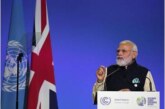 The pace of economic growth in India currently is in an accelerated mode and the need for keeping up this momentum calls for making our villages as focal point of development. As Gandhiji said that real India lives in the villages, hence real growth can be had by concentrating on the villages. However, the major chunk of economic benefits accruing from economic liberalization, globalization and privatization has remained confined mainly to the urban areas and most of the villages, particularly in the remote areas have remained bereft of those benefits, thereby leading to emergence of India – denoting urban areas and Bharat – signifying rural areas.
The pace of economic growth in India currently is in an accelerated mode and the need for keeping up this momentum calls for making our villages as focal point of development. As Gandhiji said that real India lives in the villages, hence real growth can be had by concentrating on the villages. However, the major chunk of economic benefits accruing from economic liberalization, globalization and privatization has remained confined mainly to the urban areas and most of the villages, particularly in the remote areas have remained bereft of those benefits, thereby leading to emergence of India – denoting urban areas and Bharat – signifying rural areas.
However, India and Bharat are not separate geographical entities but constitute one juridical geographical entity. India signifies urban areas while Bharat represents rural areas. This divisive nomenclature emanates from vast economic disparities and differences in socio-cultural ethos between the rural and urban population of India. The CPM leader Sitaram Yechurry has opined that there are two Indias in the making – ‘the Indian Premier League or IPL India’ represented by handful millionnaires and billionnaires, and the ‘Below Poverty Line or BPL India’, which encompasses vast majority of population. One official survey says 20% of rural India lives on Rs 12 a day. Another survey states 77% of the country survived on less than Rs 20. Contrary to the expectations of proponents of neo-liberal regime, it appears gains of a growing economy have remained confined to the elite in urban areas and these are not trickling down to rural areas.
While India believes in the West, Bharat reposes its trust in the ancient culture of the land. While India looks towards the west for solutions, Bharat looks within for solutions. The Indian outlook is materialistic, while the Bharathiya ethos views spirit as primary and believes in the spiritual approach. While India believes in self-indulgence, Bharat believes in sacrifices. While India believes in individualism, Bharat believes in family values. The list seems to be endless. Only when a nation progresses along its roots, it truly advances. Indigenous growth is better than imitation of the west any day. Well-concerted policies need to be devised to narrow down this gap.
According to a recent media report, the Government of Maharashtra has embarked on an ambitious programme of establishing Eco villages under the Eco Village Programme which includes tree plantation and rural sanitation, combined with planned development of villages. Launched on 2 October 2010, the programme could cost the State Rs. 450 crores. To qualify under the eco village programme, each village has to achieve the target of “one person one tree,” at least 60 per cent of the families have to build toilets and avoid open defecation, and tax collection should be around 60 per cent. About 14,000 gram panchayats are set to qualify for the eco village programme and funds will be allotted to them for further development, depending on the size of their population. The motivation to qualify is the extra funds.
According to Ajit Pawar, the Rural Development Minister of Maharashtra, who has embarked on a whirlwind tour across the State, the formula is simple – “think globally, act locally”. Each person in the village has to plant at least one tree; that was the initial programme that preceded the eco village concept. Ajit Patil’s interactive speeches are full of climate change references, humourous appeals to build toilets, and the audience is responsive. This programme is reportedly showing good results and rural people are responding to it enthusiastically. This Eco Village programmes should be emulated by other states for better management of indigenous resources and climate change.
Villages are not only basis of clean environment but foundation of India’s growth. Agriculture, natural resources, and bulk of population are available in the rural India. An equitable and balanced growth is the need of the hour.
By Dr. Arvind Kumar



